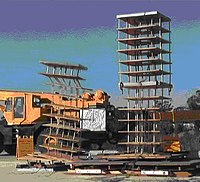
Photo from wikipedia
Abstract The aim of this study is to incorporate the local inelastic demands of a multistory reinforced concrete (RC) frame structure for the first time in the probabilistic seismic assessment… Click to show full abstract
Abstract The aim of this study is to incorporate the local inelastic demands of a multistory reinforced concrete (RC) frame structure for the first time in the probabilistic seismic assessment of the pounding risk. Two distinct types of structural pounding are examined: a) the floor-to-floor structural pounding - Type A, and b) the inter-story (floor-to-column) structural pounding - Type B. Three different initial gap distances dg between the adjacent structures are considered. The seismic performance of the RC frame structure without the pounding effect is also estimated. The probabilistic evaluation of the pounding effect is performed through fragility curves in terms of global and local engineering demand parameters (EDPs) as a function of the peak ground acceleration (PGA). The first part of this research is focused on the development of global and local probabilistic seismic demand models (PSDMs) against pounding risk. For this purpose, linear and bilinear regression models have been used. Afterwards, the fragility assessment of the RC frame against pounding is performed (a) as a function of the separation gap distance dg, (b) based on the global seismic performances, and (c) based on the local seismic performances. A compounded fragility-based solution on evaluating the pounding risk at different performance levels is also presented and new performance levels thresholds are introduced. Results indicate that the local performances of the columns of the RC structure are crucial demand parameters for the probabilistic assessment of the pounding risk. The type of the structural pounding (Type A or Type B) that is occurred between the adjacent structures significantly alters the results of the probabilistic assessment when the local performances are considered. The compounded evaluation of the pounding risk clearly indicates that the RC frame structure exceeds the examined performance levels at a lower value of PGA when subjected to pounding in comparison to the corresponding cases without pounding. Finally, a decision method is presented as an approach to estimate the minimum separation gap distance dg,min between adjacent structures when global and local performances are incorporated in the fragility assessment process.
Journal Title: Engineering Structures
Year Published: 2021
Link to full text (if available)
Share on Social Media: Sign Up to like & get
recommendations!